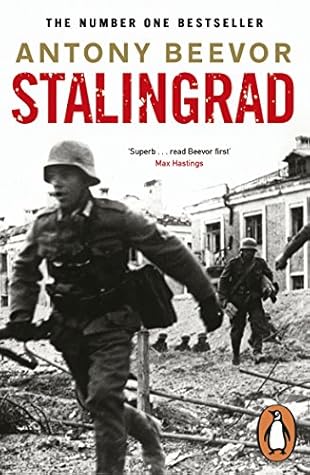More on this book
Community
Kindle Notes & Highlights
His subordinates were convinced that he could not face the prospect of destroying what he saw as his most important achievement, the Molotov – Ribbentrop Pact. He may also have started to suspect that Hitler’s reckless gamble could turn into the greatest disaster in history.
‘You’ll regret this insulting, provocative and thoroughly predatory attack on the Soviet Union. You’ll pay dearly for it!’ He turned away, followed by Berezhkov, and strode towards the door. Ribbentrop hurried after them. ‘Tell them in Moscow’, he whispered urgently, ‘that I was against this attack.’
The further they advanced into Russia, the harder it was to bring supplies forward. Panzer columns racing ahead frequently had to stop through lack of fuel.
Never did a population suffer so much from both sides in a war. Stalin had signed an order on 17 November ordering Red Army units – aviation, artillery, ski-troops and partisan detachments – to ‘destroy and burn to ashes’ all houses and farms for up to forty miles behind the German lines to deny the enemy shelter. The fate of Russian women and children was not considered for a moment.
The terrible truth, which very few officers could bear to recognize, was that the army’s tolerance or support for the Nazi doctrine of a ‘race war’ on the eastern front, exempt from normal military and international law, was bound to turn it into a semi-criminal organization.
One of the main dangers they faced was from Red Army soldiers, cut off by the rapid advance, attacking from behind or from the flank. On many occasions, when German soldiers fired back, the Red Army soldiers fell, feigning death, and lay there without moving. When the Germans approached to investigate, the Soviet soldiers waited until almost the last moment, then ‘shot them at close range’.
Ammunition and rifles were distributed, but many men received a weapon only after a comrade was killed.
The battalion commissar was a young woman mechanic from the tractor plant, which had been converted to build T-34s. There, volunteers jumped into the tanks even before they had been painted. As soon as ammunition, stacked in the factory, had been loaded, they drove them off the production line and straight into battle.
Each time there was a lull in the bombardments, women and children appeared out of holes in the ground to cut slabs of meat off dead horses before homeless dogs and rats stripped the carcass. The chief foragers were children. Younger, smaller and more agile, they presented less of a target.
Even the name ‘camp’ was optimistic, since they were just a large encirclement of barbed wire on the open steppe. There were no huts. The prisoners tried to dig holes in the ground with their bare hands to escape the biting winds, then huddle together.
Close by, a platoon from another regiment fought until only four were left alive and their ammunition ran out. A wounded man was sent back with the message: ‘Begin shelling our position. In front of us is a large group of fascists. Farewell comrades, we did not retreat.’
As a symbol of determination for revenge, the new Red Army practice in Stalingrad, when saluting the death of a well-regarded commander, was to fire a volley or salvo ‘not in the air, but at the Germans’.
At a time when Hitler still refused to countenance the idea of German women in factories, Soviet production depended on the mass mobilization of mothers and daughters.


